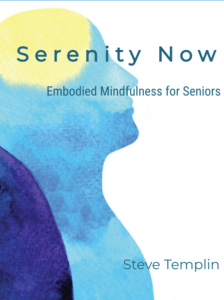What’s motivating this post about painful loss is my felt pain of losing hope for the creation of a more just and sustainable future for people and our planet. It’s about lost hope for the hundredth monkey principle to finally kick in with a surge of consciousness that would allow kindness and cooperation to replace egocentric selfishness and greed.
There’s a natural tendency to resist pain, whether it’s emotional or physical, as a way of protecting ourselves. In the short term resisting and contracting against pain can be an effective strategy.
However, when resistance and contraction become ingrained and unconscious ways of protecting ourselves, we’re not only distancing from our pain but from a felt connection with our ourselves, others, and the environment.
When we chronically cut ourselves off from the flow of life, the flow of feelings and sensations, the present moment, that disconnection is often experienced as anxiety, depression, painful symptoms and other forms of stress-induced illness.
When we resist painful feelings and sensations we trigger the stress response and brainwaves becomes destabilized and the brain is sensitized to create more emotional or physical pain and symptoms. This post, part one of two, will look at effective strategies for balancing brain function and for restoring a deeper sense of connection with ourselves, others, and life in general.
My hope is that our sensitivity to challenging emotional conditions doesn’t necessarily result in contraction and numbing (which are most likely the very states that led us to where our culture is today).
Sensitivity, or let’s call it enhanced awareness, can also be a means of increasing our capacity to let go and open our hearts and minds to new possibilities for moving forward with more resilience to whatever future awaits us.
This post is about letting go from not only a psychological point of view but from a more bodily oriented and neurological perspective. If there’s a value in surrendering or letting go, which I believe there is, hopefully what I share here will make that process more consciously accessible.
Letting Go
I’ll do my best here to provide some sensible and discreet steps (and the rationale) for how to let go of pain and move forward more gracefully …. or with more grace …. that’s based on research from others and my own observed and personal experience.
I’ve watch thousands of hours of real-time heart rate variability scans that reflect the balance of the autonomic nervous system, the vagus nerve, and the orderliness of brainwaves.
In a nutshell, these are physiological assessments that reflect our degree of physical ease, emotional well-being, mental clarity, and spiritual connectedness.
Hundreds of times I’ve witnessed an individual experiencing physical pain, emotional pain, or both who were instinctively resisting that pain. That inner resistance results in less order and more chaos in the nervous system and it perpetuates the painful experience.
Now here’s the remarkable part. When an individual can be supported in safely experiencing their pain (and no one really wants to do that but it is possible …. and necessary) with less resistance and a dollop or two of curiosity or caring attentiveness (the way you’d sit with a scared puppy) their neurological assessment frequently improves IMMEDIATELY.
In this new and more orderly neurological state, the pain whether physical or emotional, tends to dissolve because the more orderly neurology just won’t support it. Sometimes the dissolution is faster like an ice cube melting in a warm beverage, and sometimes slower like snow thawing in the spring.
Either way, it helps to understand that all pain, physical or emotional, is experienced in the brain. If we can change the state of our brain we can change our perception of pain.
The Symphony in Your Brain
Let’s compare the brain to a symphony orchestra.
While the maestro is backstage waiting to make an entrance, the orchestra doesn’t sound so sweet. The various sections of the orchestra, woodwinds, brass, strings, are all tuning up and are playing in different keys and on different beats. It’s pure chaos.
That chaotic state is a good metaphor for understanding how the various parts of our brain that are designed to work together lose synchrony when we avoid felt experience and the present moment. With this lack of synchronized communication our functioning across the board breaks down. This is the neurological state where most chronic pain is created.
Fortunately, the brain has a reset function that’s based not in how we think but in how we use our attention. We can learn to be the maestro that knows how to create order.
In part 2 I’ll look further into how attention influences the brain and pain. The main idea here is that ‘what’ you notice …. a sensation, a feeling, or pain … isn’t as important as ‘how’ you notice.
Noticing what we notice as a felt physical or energetic space that has volume, or distance, or shape changes the brain, your biochemistry, and your perception of yourself and life.
A simple experiment is to simply notice your right hand. Notice the felt space that it occupies. It may tingle or be warm or cold. Your hand may seem to merge with the air surrounding it and blurring its felt borders. Just notice your hand for a few minutes, notice your breath as well. Effortlessly.
Noticing hands is a good training for beginning to change the brain without moving into the vulnerability of the heart until we’ve had more practice. We’ll do that in Part 2. One of the reasons that noticing hands is effective is that they occupy a large part of brain’s real estate in the sensory cortex.


 Steve is a retired Doctor of Oriental Medicine, Acupuncture Physician, and HeartMath Trauma-Sensitive Certified Practitioner with over 35 years of clinical experience in the fields of Energy Medicine, Energy Psychology, and Biofeedback.
Steve is a retired Doctor of Oriental Medicine, Acupuncture Physician, and HeartMath Trauma-Sensitive Certified Practitioner with over 35 years of clinical experience in the fields of Energy Medicine, Energy Psychology, and Biofeedback. 